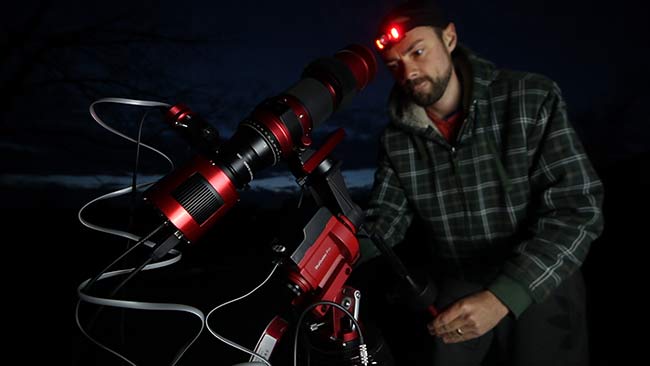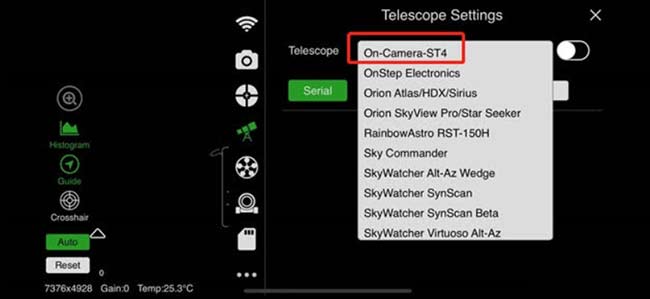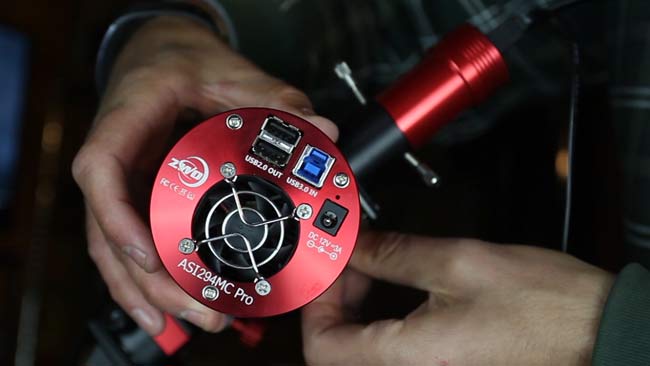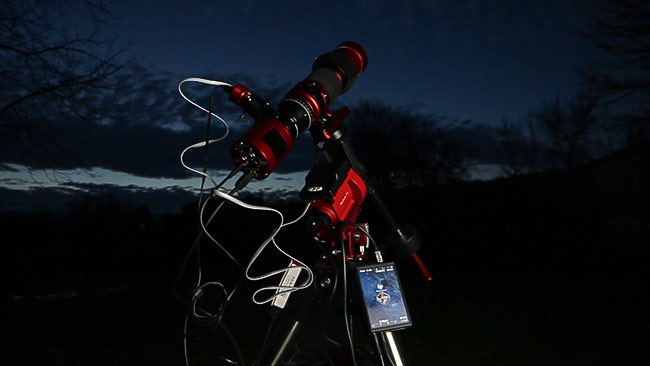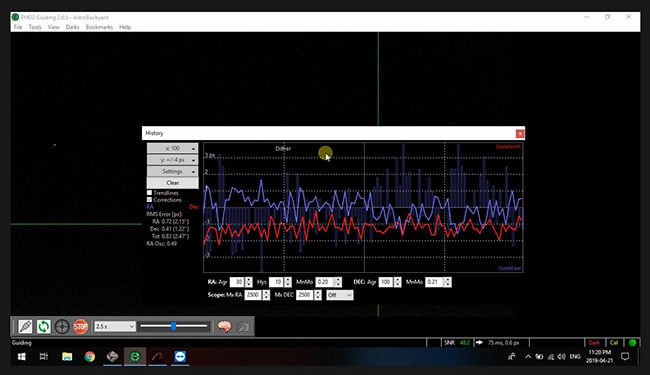Using an Off-Axis Guider for Astrophotography
When it comes to long exposure deep-sky astrophotography, autoguiding is often a necessary step towards collecting sharp images on a consistent basis. An autoguiding configuration can dramatically improve the tracking accuracy of your existing equatorial telescope mount.
Autoguiding can correct problems that come up when you’re trying to track the night sky as accurately as possible. This can include the periodic error of the equatorial telescope mount, wind, and even polar alignment. Simply put, autoguiding allows you to take longer tracked exposures that are free of trailing.
Off-axis guiding with the iOptron SkyGuider Pro.
What is an Off-Axis Guider (OAG)?
An off-axis guider (OAG) sends starlight to your guide camera using an internal pick-off prism that collects light running off of the telescope axis.
An OAG allows you to utilize your primary imaging camera and telescope for autoguiding, without the need for an additional guide scope.
At the time of writing, I have used two of-axis guiders for astrophotography. The Lumicon Easy Guider, a Starlight Xpress filter wheel, and an off-axis guider to autoguide my Sky-Watcher EQ8-R Pro telescope mount (shown below). This system utilizes a Starlight Xpress Lodestar X2 guide camera, and it has worked exceptionally well from day one.
The only challenging part was finding the right focus position for the guide camera. Even small adjustments to the camera position can make the difference between sharp stars that are perfect for guiding, and ones that are completely out of focus.
Starlight Xpress Filter Wheel and OAG.
In this post, I’ll use a Lumicon Easy Guider to guide my equatorial telescope mount for astrophotography.
Using the Lumicon Easy Guider
There are more benefits to off-axis guiding over a small auxiliary telescope setup, but first I’ll discuss the exact OAG I am using with my William Optics RedCat 51 refractor telescope.
The Lumicon Easy Guider sits between my ZWO ASI294MC Pro camera and the 2″ adapter of my telescope. The Easy Guider has an internal pick-out prism, which directs some of the light passing through the telescope to the guide camera I have fitted to the Easy Guider.
My guide camera is another ZWO ASI camera, the ASI290mm Mini. This monochrome guide camera not only fits perfectly into the Lumicon Easy Guider but can be controlled using the ZWO ASIair app along with my primary imaging camera.
I was unable to connect to the ASIair using the SkyGuider Pro at the time of writing, but the ZWO support team has provided assistance to get me sorted out for next time!
When autoguiding with the iOptron SkyGuider Pro and the ASIair, you need to select On-Camera-ST4 in the telescope settings.
Because I am using a one-shot-color dedicated astronomy camera, I am not using a filter wheel like I would with a monochrome camera. In this scenario, I need to use the supplied spacer that comes with the Lumicon Easy Guider for the correct spacing.
How an OAG (Off-Axis guider) Works
Inside of the guider body lies a prism, this prism lets light pass through it to the primary camera sensor, as well as send starlight up to the guide camera. This ingenious design allows you to use the same starfield that is being imaged as the one being used for guiding adjustments.
The exposure captured using the primary imaging camera is not negatively affected whatsoever, thanks to the design of the pick-out prism.
This was a completely new experience for me, as I have always used a traditional guiding telescope and camera riding along on top of my primary imaging telescope. An OAG removes the additional guidescope from this configuration which reduces weight and potential issues due to misalignment between the two telescopes.
Want to see another OAG in use? Chuck Ayoub shared a video discussing the Celestron Off-Axis Guider on his YouTube channel. This is another option to consider, especially if you are using a similar setup to Chuck.
Demonstrating the Celestron OAG by Chuck’s Astrophotography.
Benefits of using an Off-Axis Guider
The most obvious advantage of using an off-axis guider over a small auxiliary guide ‘scope, is that you are now using the same focal length as the imaging telescope. Your primary imaging telescope will most certainly have a larger aperture than a small guide scope, pulling in more guide stars and providing better guiding accuracy.
Another benefit to OAG is that you avoid any differential flexure occurring between your imaging telescope and the small guide telescope on top. Telescopes that require you to set the focuser drawtube farther back often have some “give” or wiggle to them that creates a separation between what your camera is seeing, and the guiding telescope fastened to the optical tube.
An OAG will detect the flexure in your imaging train and make the necessary guiding adjustments for the movement of your camera sensor at the end of the telescope.
Connecting the ZWO ASI294MC Pro camera to the Lumicon Easy Guider.
Potential Issues and Best Practices
As you can imagine, for the OAG system to work effectively, you need enough starlight to be “picked up” from the prism in front of your imaging camera. Adding strong filters in front of an OAG will reduce the starlight signal your guide camera receives.
A weak signal will make it hard to detect a useful guide star. For this reason, it is best to place the off-axis guider in front of any filters so it can receive the strongest signal possible.
The Lumicon Easy Guider OAG may not be the best solution for those using small, or slow optical systems. You’ll need enough aperture to pull in a guide star to the relatively small field of view pick-off from the prism to your guide camera.
A camera with a large image sensor requires that the OAG be placed further away from it so that it does not obstruct the optical path. This may lead to stars that are no longer pinpoint, so make sure that your guiding software is able to identify the center of the star properly in this scenario.
Most guiding software such as PHD2 or Maxim DL can handle stars that are not perfectly round. In my tests, the autoguiding tool within the ZWO ASIair had no trouble using the guide stars it found with the 290mm Mini in the Easy Guider.
Helpful Resource: OAG vs. Guidescope (Astrojolo)
My Setup using a Small Refractor
As I mentioned earlier, I am using the William Optics RedCat 51 refractor. This is a compact imaging APO (Petzval Quad) with a diameter of 51mm, and an f-ratio of F/4.9. Consider my experiences using this to be about as small and slow as I would recommend for using an OAG system.
Using this telescope, I was able to find a useful guide star in any area of the night sky I was photographing. With that being said, this is largely due to the fact that I am using a monochrome guide camera that is very sensitive. The ASI290mm Mini can pull in a lot of stars despite the limited aperture of the telescope used.
It was satisfying to finally utilize the autoguiding feature of the iOptron SkyGuider Pro. This little mount is a pleasure to use because it is just so quick and easy to set up. If you want to learn more about the SkyGuider Pro, please see my detailed review.
If you are autoguiding with the iOptron SkyGuider Pro, remember that there is no Declination (DEC) motor. You’ll have to turn DEC guiding off in your guiding software to properly calibrate the mount.
Final Thoughts
A piggybacked guidescope and guide camera that is mounted to your primary imaging telescope may work absolutely fine for your deep-sky astrophotography. In fact, there are many scenarios when this type of configuration is the best choice for your rig, especially if you are using a small refractor telescope.
Where you may run into trouble, is in the mechanics of the system. Any flexure in the telescope focuser or optical tube will create a mismatch between your autoguiding system and your imaging train. Those using a compact refractor with a secure and robust focuser likely won’t have this issue, but a large Newtonian with a stock focuser might.
Your guide camera must be sensitive enough to reveal a useful guide star in every possible imaging location you spend time on. If you are using a color guide camera, or a slower optical system, an OAG may not be able to detect a guide star in some of the more “empty” areas of the night sky.
My guiding graph in PHD2 Guiding using the OAG with the iOptron SkyGuider Pro.
Conclusion
I love the idea of removing an element of potential error in my optical system. I am sure I have experienced the negative effects of differential flexure in my astrophotography setup in the past, but at the time I didn’t know why my guiding was poor.
At the end of the day, an OAG is a perfect solution to improve autoguiding in certain setups, and potentially un-needed or impractical in others. If you are considering switching from a secondary guide scope configuration to an OAG setup, I remind you to first remember this old saying: “If it ain’t broke, don’t fix it”.
If you feel that differential flexure is affecting your autoguiding, an off-axis guider may be the answer you’ve been looking for.
I am happy to have finally experienced an OAG system thanks to the Lumicon Easy Guider and to understand just a little bit more about the hobby of astrophotography overall.
